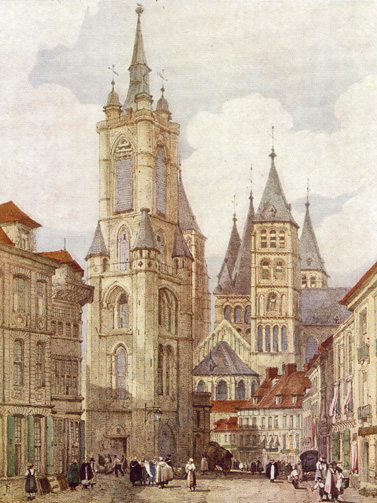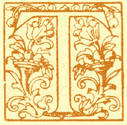
From, Beautiful Buildings in France & Belgium, Including many which have been destroyed during the war. Reproductions in Colour and Monochrome from rare old Prints and Drawings, by and after Prout, Boys, Coney, W. Callow, David Roberts, C. Wild and others, with descriptive notes, by C. Harrison Townsend, F.R.I.B.A.; New York: The Hubbell Publishing Co., 1916; pp. 198-203.
TOURNAI : CATHEDRAL AND BELFRY
(S. Prout)
 HE history of Tournai, the most important town in Hainault, and one of the most ancient in Belgium, is not so largely written for us in its architecture as is the case with other Belgian cities. It has led a troublous life, in the course of which it has not only undergone many sieges, but was sacked at various epochs by the Vandals, Normans, French, and Spaniards. In these our own days the worst lot of all has befallen it.
HE history of Tournai, the most important town in Hainault, and one of the most ancient in Belgium, is not so largely written for us in its architecture as is the case with other Belgian cities. It has led a troublous life, in the course of which it has not only undergone many sieges, but was sacked at various epochs by the Vandals, Normans, French, and Spaniards. In these our own days the worst lot of all has befallen it.
The Civitas Nerviorum of Cæsar, Tournai was, later, the seat of the Merovingian kings, but its re-building under Louis 200 XIV cleared away many of the earlier houses and monuments, and beyond the few Romanesque remains it has to show, and here and there an interesting mediæval house, few traces of its venerable age now exist.
The Cathedral is an imposing example of the Romanesque style, though its original façade was altered considerably, and a porch (not shown in the illustration) — noteworthy for its sculptures of the Creation and Fall — was added, in the Pointed style, about the middle of the XIVth century. The removal of the buildings, shown in Prout’s charming and characteristic sketch as clustering round its base, has revealed much of the beauty of this noble church.
The Belfry, that feature of so much prominence in most Belgian towns — Ypres, Bruges, Ghent, Mons, Nieuport, for example — underwent considerable modification in the 201 restoration that took place some thirty years after the drawing was made, and this record of its earlier state is an interesting one.
The steeple now existing was added at that time — in 1852, the year in which Prout died — and his view enables us to come to the conclusion that this subsequent work has not been altogether an improvement.
Copyright © 2007 by Elfinspell